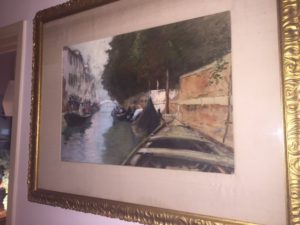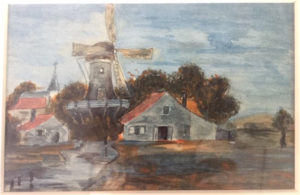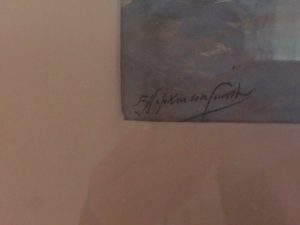 PS sends me a beautiful oil pastel on paper, signed F. Hopkinson Smith (1838-1915). The painting depicts a canal scene in Venice, but look closer, you will see an amazing rendering of perspective. This is called ‘forced’ perspective, when the painter deliberately bends the optics of the painting to convince the viewer he/she is IN the scene itself. See how the gunwale of the boat is larger than if it were ‘real,’ like a modern day photo, shot with wide-angle lens?
PS sends me a beautiful oil pastel on paper, signed F. Hopkinson Smith (1838-1915). The painting depicts a canal scene in Venice, but look closer, you will see an amazing rendering of perspective. This is called ‘forced’ perspective, when the painter deliberately bends the optics of the painting to convince the viewer he/she is IN the scene itself. See how the gunwale of the boat is larger than if it were ‘real,’ like a modern day photo, shot with wide-angle lens?
Hopkinson Smith executed this painting in an era when NEW artists used photography to SHOW the visual world how to widen a composition at the ‘entry’ to the piece in mechanical terms. The entry in this case is the boat. We picture ourselves standing on it to see down the canal.
This painting represents a merging of the two worlds
It shows the world of the painter, and the world of the technician. The realism photography availed actually led to the artists of the era to rethink perspective and the uses of color. This happened before the first color photo. Louis Ducos du Hauron took the oldest known color photograph in 1872.
Hopkinson Smith painted this in the 1870-1880’s, as painters began to know the mechanical language of photography. in fact, it became understood how the eye, with the camera, foreshortens or widen ‘angles.’ Color emphasizes this perspective Notice the greys of the boat fading.
Now to my mention of the word ‘technician’ in reference to this painter.
 When I see the expert use of angles in a composition, I immediately think of the artist as a bit of an engineer. Hopkinson Smith obviously knew mathematical perspective, how to widen the plane so that the eye was ‘fooled’ into thinking that a two dimensional space became a ‘deep’ three dimensions.
When I see the expert use of angles in a composition, I immediately think of the artist as a bit of an engineer. Hopkinson Smith obviously knew mathematical perspective, how to widen the plane so that the eye was ‘fooled’ into thinking that a two dimensional space became a ‘deep’ three dimensions.
Hopkinson Smith possessed an engineering background, as well as art training.
I have seen this coupling of technical skill and color in my own life. My grandfather Herbert (b. 1902, Leipzig) worked as an engineer who painted with perspective in his young years. The painting of the windmill pictured here is my grandfather’s.
So who was Frances Hopkinson Smith?
 He worked as a contractor in naval engineering New York City after the Civil War who created the foundation for the Statue of Liberty in New York Harbor. He designed many breakwaters, including Block Island’s. He designed the sea wall around Governor’s Island. When not building for lighthouses and bridges, he traveled and sketched Cuba, Mexico, Constantinople, and Venice, as well as Holland. He wrote novels and travel books, and illustrated them. PS might have a sketch for The Venice of To-Day 1897, or Gondola Days of 1897.
He worked as a contractor in naval engineering New York City after the Civil War who created the foundation for the Statue of Liberty in New York Harbor. He designed many breakwaters, including Block Island’s. He designed the sea wall around Governor’s Island. When not building for lighthouses and bridges, he traveled and sketched Cuba, Mexico, Constantinople, and Venice, as well as Holland. He wrote novels and travel books, and illustrated them. PS might have a sketch for The Venice of To-Day 1897, or Gondola Days of 1897.
What this painting teaches us is that artists are often ‘Renaissance’ men and women. Hopkinson Smith was an engineer who understood hydraulics, a painter who understood perspective and color, and who was famous as a fiction writer. He wrote 20 novels, two of which, Tom Grogan (1869) and Caleb West (1898), became bestselling books in the years they were released.
As he traveled, wrote, and sketched, he realized he loved the arts more than NYC civil engineering, and he retired his position. Born in Baltimore, he felt a kinship with the American South. He became famous for his novels of the antebellum American South, and his novel Colonel Carter of Cartersville (1891) was staged for the theater, playing to sell-out audiences in the larger “Northern” cities.
Recently, (Sotheby’s, 2015), a Hopkinson Smith painting, Under the Umbrella: Inn of William the Conqueror, sold ($8,000) that I’d have loved to buy. This Inn in Normandy marked the ‘setting off point’ of William’s crusade. But for Hopkinson Smith it marked a place where he reveled in the company of genteel artists and writers who gathered at that Inn each tourist season, telling stories, painting, visiting the nearby chateaux, eating, drinking and walking together.
Yes, idyllic. Yes, moneyed. Yes, the ‘haves’ entertained each other. Yes, the ‘cultivated’ of the era gathered. The artists among the world of the late 19th century were divided, and the arts showed the rift. in Hopkinson Smith’s painting we see the placid without political overtones, and at the same time, artists began painting the growing world of the slums, and downtrodden of the great cities, the disillusioned, also shot by the world’s first documentary photojournalists.
PS has a treasure on his hands. This mixed media piece, a pastel on paper with gouache, will sell for $7,000-8,000 today.